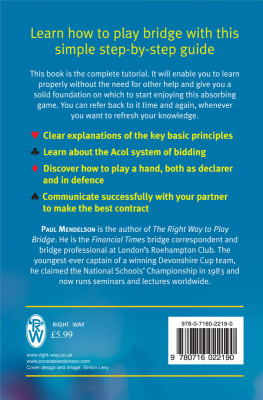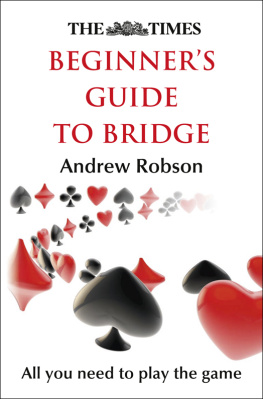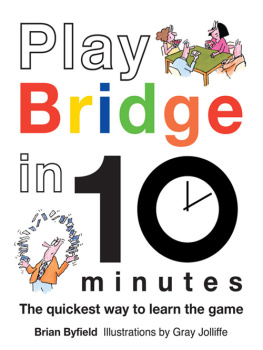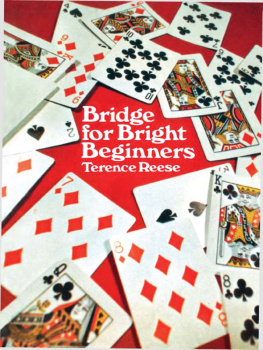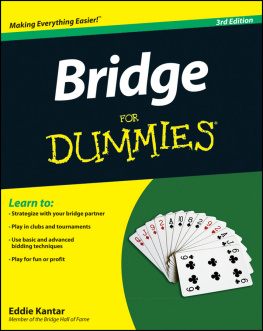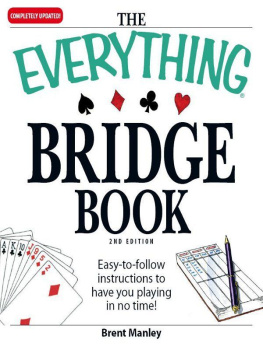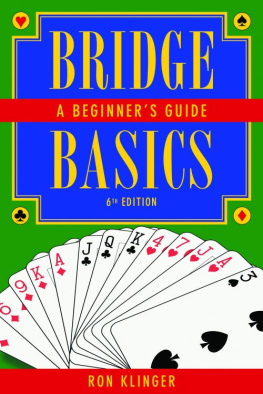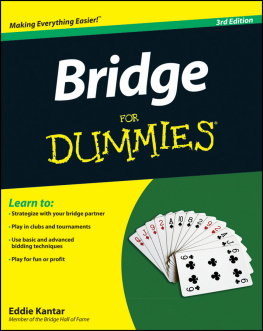Ive played them all, baseball, football, basketball, tennis, golf. Without any question, bridge tops them all. For one thing, you dont have to worry much about spraining ankles, pulling Achilles tendons, getting tennis elbow, or anything like that. Ive played poker, gin rummy, canasta, and pinochle. Bridge beats them, too.
While it might not be as physically challenging as the active sports, it keeps your brain cells moving, and as you age that might be more important than your muscles and tendons.
It beats the other card games because bridge is first and foremost a partnership game. You dont play it alone, so it teaches patience, compassion, and how to get along with others.
When you play bridge, all your troubles melt away because you are deep in thought about how to bid and then how to play the hand. Another beauty of bridge is that no two hands are alike. Because they vary, each presents challenges unique to that hand. You often find yourself in a pickle you havent faced before, but you have to determine how to handle it right then. Its not going to go away.
Be forewarned, however: bridge is an addiction. When you find a partner you like, youll want to play it more and more. Nowadays, you can even play on the internet. I dont do that much, if at all, because I like the social aspects of the game, getting out with people. It doesnt matter whether you agree on sports, arts, or politics, if they are bridge players, they are comrades. Everything else goes away while youre at the table.
Why This Book Is Different from the Others
This is not your standard how to play bridge book. While its basic purpose is to teach you how to easily play the game starting from scratch, what makes it unique is that it doesnt stop there. It continues from teaching you the basic game to also teaching you advanced techniques used by experts.
Not only will you learn the basic game of Standard American, you will also learn Two Over One, a system used by many of the best players today. In addition to learning standard bidding and carding techniques, youll also learn advanced bidding techniques like Weak Twos, New Minor Forcing, Negative Doubles, Jacoby Transfers, Jacoby Two No Trump, Splinters, and many more advanced methods of communicating with your partner that you wont find in most basic bridge books.
While learning basic playing techniques like the finesse, youll also learn advanced ways to play the cards like Ducking, the Strip and End Play, and numerous other techniques used by advanced players. Its all here in one easy-to-read simple book.
Furthermore, most of the hands used in the book are actual hands that I have played, not hands drafted to show a specific point.
How This Book Is Organized
Ive broken this book into the following parts:
In , I offer an easy-to-understand explanation of the game and rules of bridge, introduce you to basic bridge terminology, and teach you how to score. After reading these chapters, you should be able to sit down at the table with three other people and play some hands. Readers who know the basic game may skip these chapters.
, focuses exclusively on the opening bidder, the first person to make a bid. The chapters in this part tell you how to evaluate your hand in order to determine whether or not you should be the first bidder and describe the different ways you can open the bidding.
, introduces the modern bidding technique of Weak Twos and how to respond to them and bid against them. It then switches focus to the partner of the player who opens the bidding. Here you find out how to evaluate your hand after your partner has opened so that you can make a decision on how to bid. Your aim is to give your partner as much information about your hand as you can with a single bid.
, pushes deeper into the nuances of bidding. You find out how the opening bidder makes the first rebid after hearing her partners response, and how that responder should in turn rebid. This part also explores the fun concept of slam, which is when you take all or all but one of the tricks. Next, we talk about how to bid if your opponents open the bidding, how to make an overcall or a takeout double, and how to respond if your opponents do the same. We tell you all about takeout doubles, defensive bidding, and penalty doubles. Finally, we touch on the all-important topic of partnership etiquette.
, is devoted to the play of the hand after the bidding has been completed. It details how a declarer plays the hand and how defenders defend the hand, and explains specific techniqueslike taking a finesse, counting points in partners hand from the bidding, and defending after the opening lead. It concludes with a chapter on the basics of how to play Two Over One, a system that has become immensely popular.
Part 1
INTRODUCTION
TO BRIDGE
Be forewarned, bridge is an addictive game. Once you get your first taste of how much fun you can have playing it, you might very well be hooked for life. In this part, I whet your appetite by introducing you to the basics of the game. Bridge has its own unique language, which you will begin to grasp as you find out about the bidding process and how to play a hand. After you finish reading these four short, easy-to-read and easy-to-understand chapters, bridge will no longer be a mystery, and youll be firmly on the road to becoming a bridge player.
Chapter 1
Welcome to
Bridge!
Can you add to 40? Can you count to 13? If you can do these two things, you can play bridge.
Card games have been around for at least a millennium. Bridge is a fast-paced four-player card game played with a standard 52-card deck. Its reliance on concentration and skill has made it popular with all ages for more than 75 years. This chapter gives you a brief history of how contract bridge came to be, and what you need to play the game.
Bridge Basics
Bridge is played by four people, comprised of two pairs. You and your partner play against two other people. At the table, you are positioned opposite your partner while your opponents sit on either side of you.
By the way, in the examples throughout this book, your partner will be female and your opponents will be male, so references to your partner will be to she and her and references to your opponents will be he and him. Ive adopted this convention to keep from getting twisted up in the pronouns, but of course you can play bridge with any combination of either sex!
In bridge terminology, you are sitting in directions named after points on the compass. So, if you and your partner are sitting North-South, your opponents are sitting East-West, and vice versa. These are just terms and have no relevance to true magnetic north.


